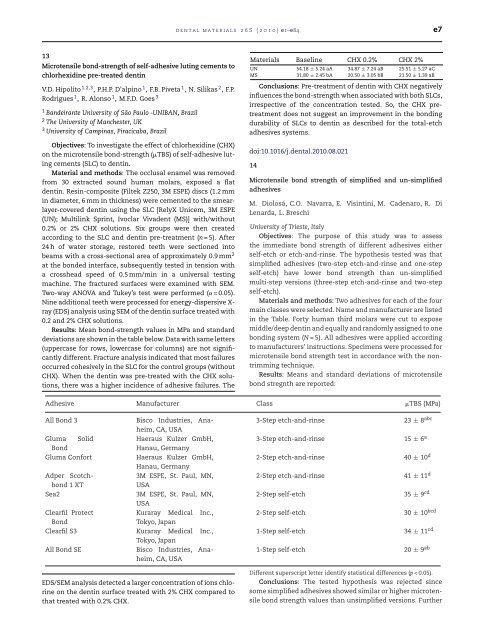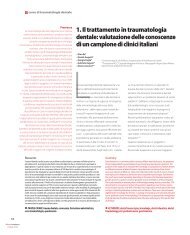Abstracts of the Academy of Dental Materials Annual ... - IsiRed
Abstracts of the Academy of Dental Materials Annual ... - IsiRed
Abstracts of the Academy of Dental Materials Annual ... - IsiRed
You also want an ePaper? Increase the reach of your titles
YUMPU automatically turns print PDFs into web optimized ePapers that Google loves.
13<br />
Microtensile bond-strength <strong>of</strong> self-adhesive luting cements to<br />
chlorhexidine pre-treated dentin<br />
V.D. Hipolito 1,2,3 , P.H.P. D’alpino 1 , F.B. Piveta 1 , N. Silikas 2 , F.P.<br />
Rodrigues 1 , R. Alonso 1 , M.F.D. Goes 3<br />
1 Bandeirante University <strong>of</strong> São Paulo -UNIBAN, Brazil<br />
2 The University <strong>of</strong> Manchester, UK<br />
3 University <strong>of</strong> Campinas, Piracicaba, Brazil<br />
Objectives: To investigate <strong>the</strong> effect <strong>of</strong> chlorhexidine (CHX)<br />
on <strong>the</strong> microtensile bond-strength (�TBS) <strong>of</strong> self-adhesive luting<br />
cements (SLC) to dentin.<br />
Material and methods: The occlusal enamel was removed<br />
from 30 extracted sound human molars, exposed a flat<br />
dentin. Resin-composite (Filtek Z250, 3M ESPE) discs (1.2 mm<br />
in diameter, 6 mm in thickness) were cemented to <strong>the</strong> smearlayer-covered<br />
dentin using <strong>the</strong> SLC [RelyX Unicem, 3M ESPE<br />
(UN); Multilink Sprint, Ivoclar Vivadent (MS)] with/without<br />
0.2% or 2% CHX solutions. Six groups were <strong>the</strong>n created<br />
according to <strong>the</strong> SLC and dentin pre-treatment (n = 5). After<br />
24 h <strong>of</strong> water storage, restored teeth were sectioned into<br />
beams with a cross-sectional area <strong>of</strong> approximately 0.9 mm 2<br />
at <strong>the</strong> bonded interface, subsequently tested in tension with<br />
a crosshead speed <strong>of</strong> 0.5 mm/min in a universal testing<br />
machine. The fractured surfaces were examined with SEM.<br />
Two-way ANOVA and Tukey’s test were performed (˛ = 0.05).<br />
Nine additional teeth were processed for energy-dispersive Xray<br />
(EDS) analysis using SEM <strong>of</strong> <strong>the</strong> dentin surface treated with<br />
0.2 and 2% CHX solutions.<br />
Results: Mean bond-strength values in MPa and standard<br />
deviations are shown in <strong>the</strong> table below. Data with same letters<br />
(uppercase for rows, lowercase for columns) are not significantly<br />
different. Fracture analysis indicated that most failures<br />
occurred cohesively in <strong>the</strong> SLC for <strong>the</strong> control groups (without<br />
CHX). When <strong>the</strong> dentin was pre-treated with <strong>the</strong> CHX solutions,<br />
<strong>the</strong>re was a higher incidence <strong>of</strong> adhesive failures. The<br />
EDS/SEM analysis detected a larger concentration <strong>of</strong> ions chlorine<br />
on <strong>the</strong> dentin surface treated with 2% CHX compared to<br />
that treated with 0.2% CHX.<br />
dental materials 26S (2010) e1–e84 e7<br />
<strong>Materials</strong> Baseline CHX 0.2% CHX 2%<br />
UN 54.18 ± 5.24 aA 34.87 ± 7.24 aB 25.51 ± 5.27 aC<br />
MS 31.80 ± 2.45 bA 20.50 ± 3.05 bB 21.50 ± 1.39 aB<br />
Conclusions: Pre-treatment <strong>of</strong> dentin with CHX negatively<br />
influences <strong>the</strong> bond-strength when associated with both SLCs,<br />
irrespective <strong>of</strong> <strong>the</strong> concentration tested. So, <strong>the</strong> CHX pretreatment<br />
does not suggest an improvement in <strong>the</strong> bonding<br />
durability <strong>of</strong> SLCs to dentin as described for <strong>the</strong> total-etch<br />
adhesives systems.<br />
doi:10.1016/j.dental.2010.08.021<br />
14<br />
Microtensile bond strength <strong>of</strong> simplified and un-simplified<br />
adhesives<br />
M. Diolosá, C.O. Navarra, E. Visintini, M. Cadenaro, R. Di<br />
Lenarda, L. Breschi<br />
University <strong>of</strong> Trieste, Italy<br />
Objectives: The purpose <strong>of</strong> this study was to assess<br />
<strong>the</strong> immediate bond strength <strong>of</strong> different adhesives ei<strong>the</strong>r<br />
self-etch or etch-and-rinse. The hypo<strong>the</strong>sis tested was that<br />
simplified adhesives (two-step etch-and-rinse and one-step<br />
self-etch) have lower bond strength than un-simplified<br />
multi-step versions (three-step etch-and-rinse and two-step<br />
self-etch).<br />
<strong>Materials</strong> and methods: Two adhesives for each <strong>of</strong> <strong>the</strong> four<br />
main classes were selected. Name and manufacturer are listed<br />
in <strong>the</strong> Table. Forty human third molars were cut to expose<br />
middle/deep dentin and equally and randomly assigned to one<br />
bonding system (N = 5). All adhesives were applied according<br />
to manufacturers’ instructions. Specimens were processed for<br />
microtensile bond strength test in accordance with <strong>the</strong> nontrimming<br />
technique.<br />
Results: Means and standard deviations <strong>of</strong> microtensile<br />
bond stregnth are reported:<br />
Adhesive Manufacturer Class �TBS (MPa)<br />
All Bond 3 Bisco Industries, Anaheim,<br />
CA, USA<br />
Gluma Solid<br />
Bond<br />
Haeraus Kulzer GmbH,<br />
Hanau, Germany<br />
Gluma Confort Haeraus Kulzer GmbH,<br />
Hanau, Germany<br />
Adper Scotchbond<br />
1 XT<br />
3M ESPE, St. Paul, MN,<br />
USA<br />
Sea2 3M ESPE, St. Paul, MN,<br />
USA<br />
Clearfil Protect<br />
Bond<br />
Kuraray Medical Inc.,<br />
Tokyo, Japan<br />
Clearfil S3 Kuraray Medical Inc.,<br />
Tokyo, Japan<br />
All Bond SE Bisco Industries, Anaheim,<br />
CA, USA<br />
3-Step etch-and-rinse 23 ± 8 abc<br />
3-Step etch-and-rinse 15 ± 6 a<br />
2-Step etch-and-rinse 40 ± 10 d<br />
2-Step etch-and-rinse 41 ± 11 d<br />
2-Step self-etch 35 ± 9 cd<br />
2-Step self-etch 30 ± 10 bcd<br />
1-Step self-etch 34 ± 11 cd<br />
1-Step self-etch 20 ± 9 ab<br />
Different superscript letter identify statistical differences (p < 0.05).<br />
Conclusions: The tested hypo<strong>the</strong>sis was rejected since<br />
some simplified adhesives showed similar or higher microtensile<br />
bond strength values than unsimplified versions. Fur<strong>the</strong>r



